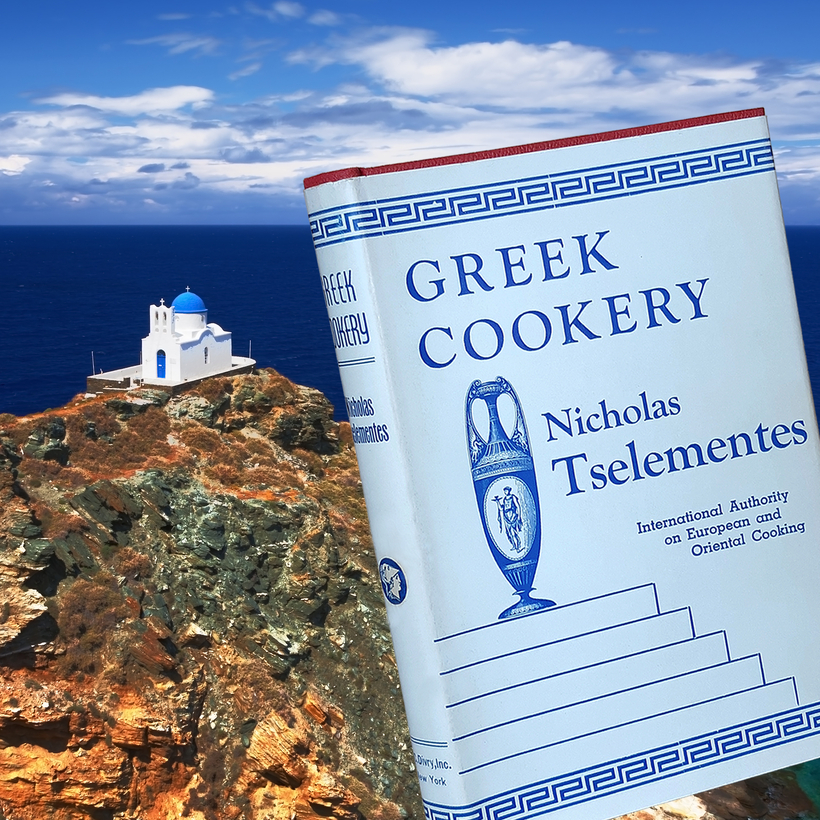Just a three-hour ferry ride from Athens, Sifnos is worlds away from its crowded, flashy neighbor, Mykonos.
Thirteen small villages, home to a population of just over 2,500, are spread across its mountains and valleys, and 235 blue-domed churches dot its beaches and cliffs. In Kastro, the ancient capital, on the coast, 14th-century fortifications surround whitewashed houses and narrow, meandering cobblestoned streets. Old men still scavenge for capers, and women with deeply lined faces sell their pottery.

Sifnos brings to mind some of Greece’s more low-key Cycladic islands—Amorgos, Folegandros—with one key difference: the food. Whereas its neighbors’ offerings tend to consist of old feta and boiled octopus, Sifnos is quietly making a name for itself as a culinary destination, spurred by sophisticated restaurants serving excellent farm-to-table food.
Bono and Scarlett Johansson are among the stars who have fought over hard-to-come-by reservations on Sifnos in the last year, moving their yachts hundreds of miles for a taste of the island.
“It blew my mind,” Leonardo Salerni, a recent visitor to Sifnos, tells me. “It’s perhaps some of the best food I’ve ever had in my life.” Vasilis Koutroulis, the owner of the NOS Hotel, in nearby Faros, told The Times of London, “Gastronomy on Sifnos is a way of life.”

The island’s culinary traditions date back some 4,000 years, to the Early Cycladic period. Sifnos’s main port was an important trading post for the ancient Greeks, giving residents access to exotic ingredients.
And while the rest of Greece was cooking on open fires, the people of Sifnos made revithada (chickpea stews) and mastelo (lamb casseroles with dill) inside heat-resistant terra-cotta pots, a product of Sifnos’s mineral-rich red soil.
Sifnos brings to mind some of Greece’s more low-key Cycladic islands—Naxos, Antiparos—with one key difference: the food.
Fast-forward to 1950, when Nicholas Tselementes, a young, ambitious Sifnian chef, published his first English-language Greek cookbook, Greek Cookery. His pairing of foreign elements—French béchamel sauce, Russian piroshki—with traditional Greek fare did not go down well initially. But in time, Tselementes’s book became world renowned, and “Tselementes” a synonym of “cookbook” in Greek dictionaries.
Today, Sifnos’s traditional tavernas—Manolis, Tsikali, Chrysopigi—still serve many of Tselementes’s recipes, such as chickpea croquettes and blanched sea samphire. But alongside them, new restaurants with new ideas are cropping up. “The island … over recent years has really seen an explosion of more high-end food,” says Sifnos resident Vasilis Oikonomou.

When Vassilis Vlachogiorgakis opened the restaurant Omega 3 on Sifnos in 2013, he envisioned something simple—bar stools strewn around a communal table on the sandy beach of Platis Gialos, a simple bamboo sheet sheltering visitors from the sun.
But the low-key locale happened to serve exquisite food and soon became a destination for large boats. Last year, Jeff Bezos, Diane von Furstenberg, and Barry Diller tendered over from Diller’s yacht, Eos, to snatch seats at the bar. Tom and Rita Hanks, who have a house on Antiparos, have also been known to make the trip for dinner.
The food at Omega 3 is tapas-style, influenced by the vision of its former chef Giorgos Samoilis, who was a molecular biologist. His carefully dissected fish cheeks are combined with minerally Greek wines. The octopus and aguachile are fresh, and the sea spaghetti is paired with beetroot chips.

In 2020, Samoilis left his post at Omega 3 to open Cantina, also on Sifnos, forgoing the experimental style for something more traditional. Perched on a cliff overlooking Kastro, the restaurant entails a 99-step descent. Waves crash on the rocks just below, sending the occasional sea spray onto the dinner plates. “This acts like a filter,” Samoilis has said, “for whoever decides to walk down the steps has already taken a conscious decision to visit Cantina.”
Fish is smoked using seaweed harvested from the nearby Seralia beach, and pigeon, formerly an island staple, is back on the menu. Dishes change every few days based on availability.
“There are two schools,” Pietro Miano, a restaurateur on the island, explains—experimental food and Sifnian cuisine. “Cantina is the latter.” Miano’s restaurants, called Mamma Mia, are some of the island’s oldest. One location is in Platis Gialos, a few steps away from Omega 3. The other is in the hilltop town of Apollonia. Both serve food from a third school: Italian, but with Greek ingredients.

In the summer months, Miano, a native of Italy who has produced music for Dua Lipa and 21 Savage, wears a chef jacket and cooks creamy pasta with clams. In August, rappers can be seen mingling in front of his restaurants. “My parents came here in 1985, so we’re like locals on the island,” he tells me. “When Kate Moss came last year, we served her pasta with prawns. It became the dish of the summer.”
Then there is Bostani, the restaurant in Sifnos’s Verina Astra hotel, which takes its name from the Greek term for “garden,” and serves plant-based dishes presided over by Nikos Thomas, of Athens’s acclaimed Simul.

The island’s bakeries, meanwhile, offer nods to Sifnos’s past colonization by the Turks. At Theodorou’s Sweet Shop, in Artemonas, amygdalota, a soft almond cookie rolled in sugar, is made from scratch and cooked on copper pots that hang over a crackling wood fire.
Whether or not the island will soon be overrun by copycat restaurants is a point of contention. A non-native restaurant that capitalizes on the island’s reputation could ruin its growing status as a gastronomic hub. “It takes a second in Greece for you to have people coming from Athens making fake versions of us,” Miano says. “If an Athenian comes and tries to copy Omega 3, or Cantina, or Mamma Mia, let’s say, things could go in the wrong direction.”
Others are optimistic that Sifnos could one day become the Greek San Sebastián. “Food is everything to us,” Oikonomou says. “I’m sure it’s only a matter of time before Michelin comes calling.”
Elena Clavarino is an Associate Editor for AIR MAIL

